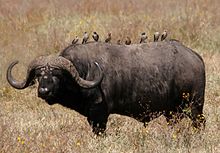Cleaning symbiosis
A cleaning symbiosis is a symbiotic partnership between different animal species in which one, usually smaller, frees the larger animal species from external parasites , skin impurities and dead skin. Cleaning symbioses occur primarily in coral reefs , but are also known from other marine biotopes, from freshwater and from land creatures.
Herodotus already reported that in Egypt small birds look for food in the mouths of crocodiles . Probably the crocodile guardian was meant, who is said to do this to this day, but this behavior has not yet been observed. A cleaning symbiosis was only proven in the 1930s, when the neon goby ( Elacatinus oceanops ) was observed and photographed during this activity on the island of Dry Tortugas near Florida .


Cleaner fish
The best known cleaning station is from the Putzerlippfischen exerted (Labrichthyini), from the species of the genera Labropsis and Larabicus only as juveniles from ordinary cleaner wrasse ( Labroides Dimidiatus ) and the other species of the genus Labroides life.
communication
A prerequisite for a cleaning symbiosis is the development of a communication system between the cleaner fish and their "customers". Cleaner fish are not taboo for predatory fish and will be eaten by them if they have misunderstood the behavior of a hunting predator.
The fish show their interest in cleansing by spreading their fins, opening their mouth and gill cover, in some species also by changing their color or becoming rigid in trance . When they swim towards the "customers", the cleaner fish identify themselves by their color with a conspicuous longitudinal stripe and a characteristic swimming style and then search the body surface, in large fish also the inside of the mouth and the inner gill space, for parasites (mostly crustaceans) and dead skin particles . The "customers" signal by twitching or other signals when they have had enough.
In the Caribbean , where there are no cleaner wrasse, gobies from the genus Elacatinus take over this function. They show a blue and yellow color pattern that is very similar to the cleaner wrasse, which is probably used all around the world to identify the cleaner fish.
Forms of cleaning behavior
With the exception of nomadic revier owning between its Damsel - "customers" roving nomad Putzerlippfischs ( Diproctacanthus xanthurus ) the cleaner fish are sedentary and maintain fixed cleaning stations to which their "customers" come to be clean around.
Other types of wrasse , butterfly and angelfish are also used as cleaners as young fish. The barber butterflyfish ( Johnrandallia nigrirostris ) carries out this activity for life and carries out mass cleaning campaigns in which more than a hundred barber butterflyfish serve hundreds of "customers".
Another form of cleaning behavior, in which not many "customers" are "served" one after the other, but only one "major customer" who has a particularly large body surface is cleaned, is practiced by the ship keepers (Echeneidae). They clean large fish such as large sharks , manta rays or whales , have a first dorsal fin that has been converted into an adhesive organ, usually attach themselves to the underside of the large animal and let them pull you along. Ship owners always eat zooplankton or snatch small parts of the prey, provided that the big fish is predatory.
Evolutionary origin
All cleaner fish with the exception of the ship keeper have developed from substrate diggers. Their ancestors ate small animals from the rock or coral underground of their habitat and only changed the substrate. Instead of grazing on solid surfaces at the bottom of shallow seas, cleaner fish search the slimy body surfaces of other fish for food. The closest relatives of the shipowners, however, are medium-sized and large predatory fish, such as the barnacles or the golden mackerel .
Cleaner shrimp
Plaster symbioses also be exercised by different shrimp species, particularly those of the genus Lysmata from partner shrimp (Pontoniinae) rhynchocinetidae (Rhynchocinetidae) and scissors shrimp (Stenopodidae). Most cleaner shrimp can be recognized by their white antennae.
Cleaning symbioses between land animals
As an example of a cleaning symbiosis between land animals, the starling genus of the maggot chopper ( Buphagus ) is often given, which rid the skin of large African grazing animals such as African buffalo or rhinoceros from parasites. However, they also feed themselves parasitically on the blood and wound edges of the host animals.
literature
- Helmut Schumacher: Coral reefs . BLV Verlagsgesellschaft, Munich 1988, ISBN 3-405-13614-8 .
Individual evidence
- ↑ Karen L. Cheney, Alexandra S. Grutter, Simon P. Blomberg, N. Justin Marshall: Blue and Yellow Signal Cleaning Behavior in Coral Reef Fishes . In: Current Biology . tape 19 , no. 15 , August 11, 2009, p. 1283-1287 , doi : 10.1016 / j.cub.2009.06.028 .
- ↑ Nomad cleaner wrasse on Fishbase.org (English)
- ↑ Barber Butterflyfish on Fishbase.org (English)
- ↑ Paul Weeks: Interactions between red-billed oxpeckers, Buphagus erythrorhynchus, and domestic cattle, Bos taurus, in Zimbabwe. In: Animal Behavior. Volume 8, No. 6, 1999, pp. 1253-1259, doi: 10.1006 / anbe.1999.1265 , PMID 10600147


